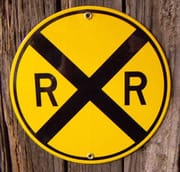
In May 2008 John Brown drove his garbage truck across a railroad crossing in Copiah County, Mississippi, and was struck by an Amtrak train operated on tracks owned by Illinois Central Railroad Company (“Illinois Central”). An advance warning sign stood 22 feet from the tracks and another warning sign stood 15 feet from the tracks. Mr. Brown’s view of the oncoming train was unobstructed, but he never stopped before entering the crossing even though the train blew its horn. It was undisputed that, at a distance of 25 feet from the crossing, Mr. Brown could see 2000 feet down the tracks.
Before trial, Amtrak and Illinois Central moved for summary judgment on Mr. Brown’s claim of breach of the common law duty to make an extrahazardous railroad crossing reasonably safe by installing active signaling devices. Of the two summary judgment motions, the court only granted the one filed by Illinois Central. Amtrak proceeded to trial and the jury returned a verdict in favor of Amtrak. Brown appealed the signalization claim against Illinois Central.
The 5th Circuit’s Analysis:
Under Mississippi law, a railroad company owes the public a duty to signalize railroad crossings and can comply with that duty by placing signs at certain distances from a railroad crossing. Miss. Cod Ann. § 77-9-247; Mitcham v. Ill. Cent. Gulf R.R. Co., 515 So.2d 852, 854-55 (Miss. 1987). However, if a railroad crossing is unusually dangerous or extrahazardous, ordinary care requires the railroad company to install active signaling devices. Ill Cent. R.R. Co. v. White, 610 So.2d 308, 318 (Miss. 1992).
The test of whether a railroad crossing is unusually dangerous or extrahazardous is the ability of the driver of a vehicle to see an approaching train. Irby v. Travis, 935 So.2d 884, 897 (Miss. 2006). When a railroad company has placed statutorily required warnings signs at a crossing, it is entitled to assume that approaching vehicles will slow to see whether a train is near. Wilner v. Miss. Exp. R.R. Co., 546 So.2d 678, 681-82 (Miss. 1989). Although demonstrating that a railroad crossing is not unusually dangerous is difficult, a party can do so through summary judgment when the evidence establishes that the driver of the vehicle had an unobstructed view of at least 1000 feet of an oncoming train. Ill Cent. R.R. Co. v. Hawkins, 830 SO.2d 1162, 1171 (Miss. 2002); Ill Cent. Gulf R.R. v. Burns, 396 So.2d 637, 640 (Miss. 1981).
In this case, Mr. Brown argued that the real issue was his sight distance before the first warning sign for the railroad tracks that was placed 22 feet out. The 5th Circuit countered that Illinois Central was entitled to rely on its warning signs placed at 22 and 15 feet from the tracks. Essentially, once those signs were placed, it was assumed that surveillance by drivers from those points was sufficient to prevent an accident. The court also noted that Mr. Brown had an unobstructed view of the train for at least 1000 feet prior to the accident and that physical condition of the crossing’s pavement was not within the control of the railroad. The 5th Circuit affirmed the summary judgment granted by the district court.
What to Take Away:
When crossing any railroad track in Mississippi, remember that the law assumes you’ve read the warning signs and are slowing down to look before you cross.

